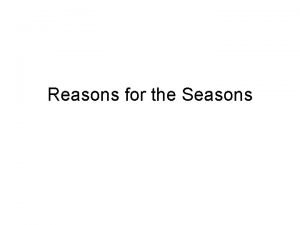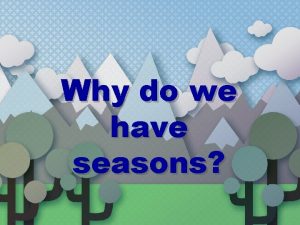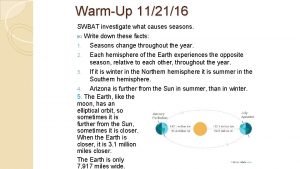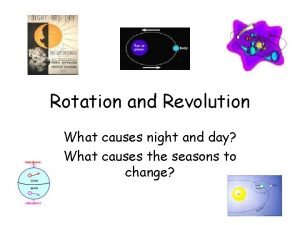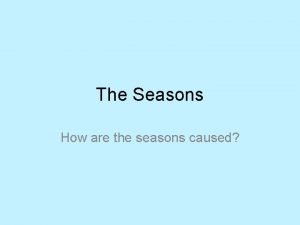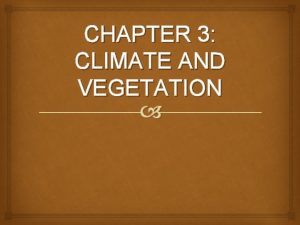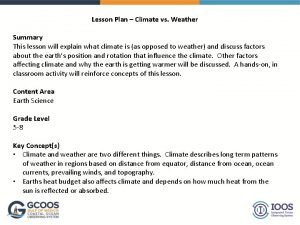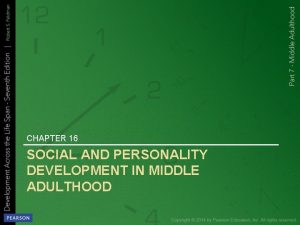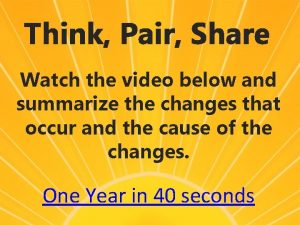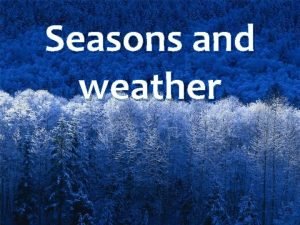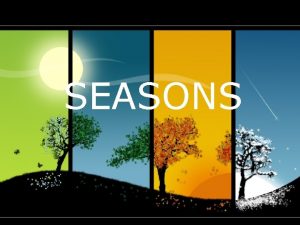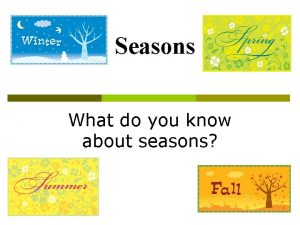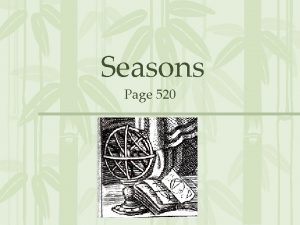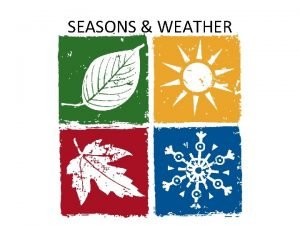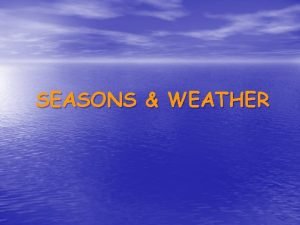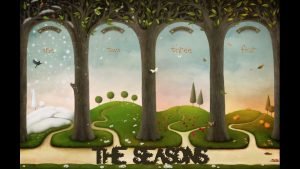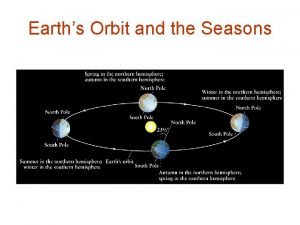Seasons What Causes Seasons n n n Seasons

















- Slides: 17

Seasons

What Causes Seasons? n n n Seasons are caused by the tilt of the earth’s axis as it moves around the sun. Seasons happen because the Earth is tilted on its axis at a 23. 5 * angle. The tilt affects how much solar energy the Earth receives as it moves around the sun.

The Earth and Sun n n The Earth rotates on its axis once every 24 hours. 1 rotation = 1 day. The Earth revolves around the sun once every 365 days. 1 revolution = 1 year.

Why does the Earth Tilt? n n If the Earth did not tilt, countries near the poles would be cold and dark all year round. If it tilted too much, the seasons would be very extreme – like on the planet Uranus. There the winter lasts for 42 years in total darkness!

Our 4 Seasons ► Spring ► Summer ► Winter ► Fall ► DO ALL AREAS OF EARTH EXPERIENCE ALL 4 SEASONS? ? ______

Summer in the Northern Hemisphere n n During our summer months, the Northern Hemisphere has warmer temperatures and longer days because it tilts toward the sun. When it is summer in the Northern Hemisphere it is winter in the southern hemisphere because it is tilted away from the sun.


Winter in the Northern Hemisphere n n During our winter months, the Northern Hemisphere is tilted away from the sun, temperatures are lower and days are shorter. In the Southern Hemisphere it is summer because it tilts toward the sun.


Seasons and The Equator • The equator receives generally the same amount • • of energy from the sun all year round. These areas have few seasonal changes. If you live near the equator, the Sun doesn't shift up and down in the sky as much. This means that the temperature doesn't vary as much. So countries near the equator only have two seasons - rainy and dry.

Seasons and Weather ►Different seasons bring different types of weather. ►This weather is caused by the heating or cooling of the Earth’s atmosphere.

Solstice • The winter solstice occurs on December 21 or 22 and marks the beginning of winter (this is the shortest day of the year). • The summer solstice occurs on June 21 and marks the beginning of summer (this is the longest day of the year).

Equinox • Equinoxes are days in which day and night are of equal duration. • 12 hours of daylight and 12 hours of darkness • The two yearly equinoxes occur when the Sun crosses the celestial equator. • The vernal equinox occurs in late March (this is the beginning of spring in the Northern Hemisphere and the beginning of fall in the Southern Hemisphere). • The autumnal equinox occurs in late September (this is the beginning of fall in the Northern Hemisphere and the beginning of spring in the Southern Hemisphere).


QUIZ • 1. Name the four seasons. • 2. Are the Earth's seasons caused by the differences in the distance from the Sun throughout the year or the tilt of the Earth's axis? • 3. What is the tilt of the Earth's axis (in degrees)? • 4. During which season do the Sun's rays hit the Northern Hemisphere at the most direct angle? • 5. During which season are the days the shortest? • 6. What is the name of the shortest day of the year (and the beginning of winter)? • 7. What is the name of the longest day of the year (and the beginning of summer)? __ • 8. What is the name of a day in which the day and night are of equal duration? • 9. How many times each year do we have days in which the day and night are of equal duration? • 10. What are the names of each of these days? • 11. How many days does it take for the Earth to rotate once on its axis? • 12. How long does it take for Earth to revolve around the sun one time?

ANSWERS • 1. Name the four seasons. summer, autumn (fall), winter, spring • 2. Are the Earth's seasons caused by the differences in the distance from the Sun throughout the year or the tilt of the Earth's axis? The tilt of the Earth's axis • 3. What is the tilt of the Earth's axis (in degrees)? 23. 45 degrees • 4. During which season do the Sun's rays hit the Earth at the most direct angle? summer • 5. During which season are the days the shortest? winter • 6. What is the name of the shortest day of the year (and the beginning of winter)? winter solstice • 7. What is the name of the longest day of the year (and the beginning of summer)? summer solstice • 8. What is the name of a day in which the day and night are of equal duration? an equinox • 9. How many times each year do we have days in which the day and night are of equal duration? 2 times • 10. What are the names of each of these days? the vernal equinox and the autumnal equinox

Earth Viewer • http: //www. fourmilab. ch/earthview/vplanet. html • Animations: http: //www. educypedia. be/education/climat eanimations. htm
 There are two seasons in a year true or false
There are two seasons in a year true or false What causes the seasons to change? *
What causes the seasons to change? * Why do we have seasons
Why do we have seasons Why do globes lean sideways brainpop
Why do globes lean sideways brainpop What causes seasons rotation or revolution
What causes seasons rotation or revolution Why seasons
Why seasons Proximate vs ultimate causation
Proximate vs ultimate causation Proximate causes vs ultimate causes
Proximate causes vs ultimate causes Continental location
Continental location Spring summer winter fall
Spring summer winter fall Spring weather
Spring weather Four seasons korean movie
Four seasons korean movie Sandwich phenomenon and empty nest syndrome
Sandwich phenomenon and empty nest syndrome Thevideo pair
Thevideo pair Spring summer autumn
Spring summer autumn How were the lives of egypt's peasants ruled by the seasons
How were the lives of egypt's peasants ruled by the seasons Four seasons weather
Four seasons weather Skip through the seasons
Skip through the seasons
